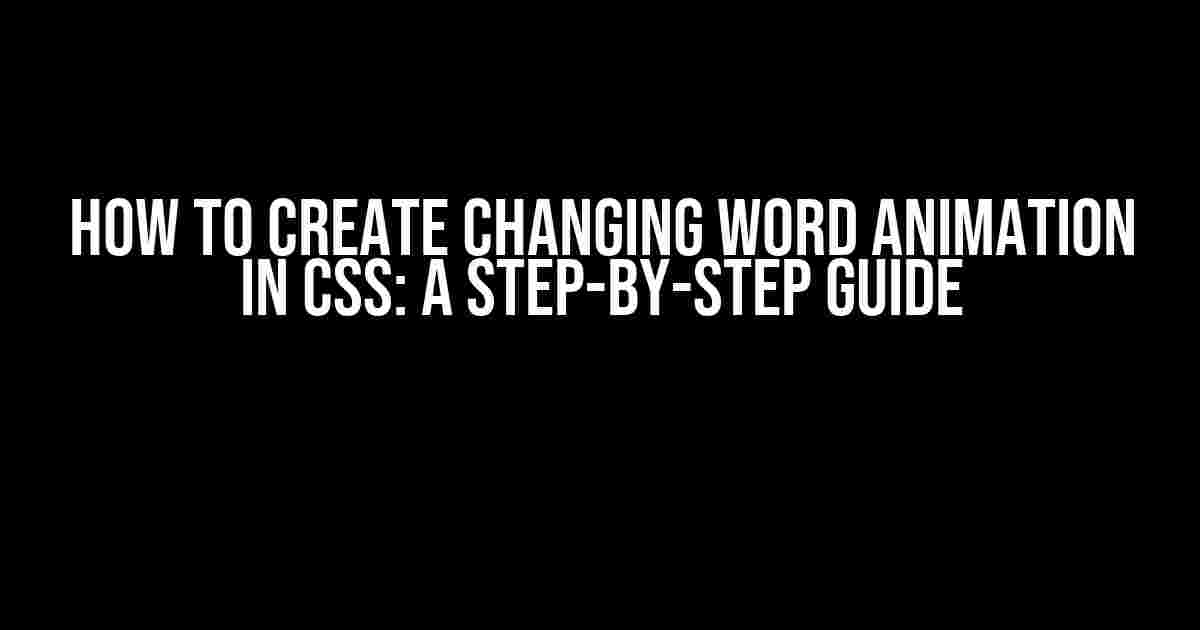Are you tired of static text on your website? Do you want to add some dynamic flair to your web design? Look no further! In this article, we’ll show you how to create a mesmerizing changing word animation in CSS that will leave your visitors mesmerized.
What is Changing Word Animation?
A changing word animation, also known as a “text switcher” or “word morphing” effect, is a technique used to dynamically change text on a web page. This effect can be used to create engaging headings, footers, or even entire sections of a website. With CSS, you can create a seamless and smooth transition between different words or phrases, adding an extra layer of interactivity to your design.
Why Use Changing Word Animation?
There are several reasons why you should consider using changing word animation on your website:
- Visual interest**: Changing word animation adds a level of visual interest to your design, making it more engaging and attention-grabbing.
- Dynamic content**: This effect allows you to display multiple pieces of information in a single space, making it perfect for highlighting different features or services.
- Interactive experience**: Visitors can interact with your animation, explore different options, and get a more immersive experience.
- SEO benefits**: By using CSS for animation, you can improve your website’s loading speed and search engine optimization (SEO).
Creating the Animation
Now that we’ve covered the basics, let’s dive into the step-by-step process of creating the changing word animation in CSS.
Step 1: HTML Structure
First, we need to create the HTML structure for our animation. We’ll use a simple `` element to wrap each word or phrase:
<span class="word">Word 1</span>
<span class="word">Word 2</span>
<span class="word">Word 3</span>Step 2: CSS Styles
Next, we’ll add some basic CSS styles to our words:
body {
font-family: Arial, sans-serif;
font-size: 24px;
}
.word {
display: inline-block;
margin: 0 10px;
transition: opacity 0.5s;
opacity: 0;
}Step 3: Animation Logic
Now, let’s create the animation logic using CSS keyframes. We’ll define a `@keyframes` rule to animate the opacity of each word:
@keyframes word-switch {
0% {
opacity: 0;
}
50% {
opacity: 1;
}
100% {
opacity: 0;
}
}Step 4: Animation Trigger
To trigger the animation, we’ll use the `:nth-child` pseudo-class to target each word and add the animation:
.word:nth-child(1) {
animation: word-switch 3s infinite;
animation-delay: 0s;
}
.word:nth-child(2) {
animation: word-switch 3s infinite;
animation-delay: 1s;
}
.word:nth-child(3) {
animation: word-switch 3s infinite;
animation-delay: 2s;
}Customizing the Animation
Now that we have our basic animation up and running, let’s explore some ways to customize it:
Changing Animation Duration
To change the animation duration, simply update the `animation-duration` property:
.word {
animation-duration: 5s; /* increase animation duration to 5 seconds */
}Adding Animation Delays
To add animation delays, update the `animation-delay` property:
.word:nth-child(1) {
animation-delay: 2s; /* add 2-second delay to first word */
}Changing Animation Timing Functions
To change the animation timing function, update the `animation-timing-function` property:
.word {
animation-timing-function: ease-in-out; /* change timing function to ease-in-out */
}Advanced Techniques
Now that we’ve covered the basics, let’s explore some advanced techniques to take our animation to the next level:
Multiple Word Animation
To animate multiple words, we can use the ` animation-fill-mode` property to control the animation’s behavior:
.word {
animation-fill-mode: forwards;
}Word Morphing
To create a word morphing effect, we can use the `transform` property to rotate, scale, or translate the words:
.word {
transform: scale(1.2); /* scale words by 20% */
}Best Practices
When using changing word animation, keep the following best practices in mind:
- Keep it simple**: Avoid over-animating or using too many words, as it can be overwhelming for visitors.
- Test thoroughly**: Test your animation on different devices and browsers to ensure compatibility.
- Optimize performance**: Use CSS optimization techniques to ensure your animation doesn’t slow down your website.
- Accessibility**: Ensure your animation is accessible by providing alternative text for visitors with disabilities.
Conclusion
Creating a changing word animation in CSS is a great way to add visual interest and interactivity to your website. By following the steps outlined in this article, you can create a smooth and seamless animation that will engage your visitors. Remember to keep it simple, test thoroughly, and optimize performance to ensure your animation runs smoothly.
| Keyword | Description |
|---|---|
| Changing Word Animation | A technique used to dynamically change text on a web page. |
| Text Switcher | An effect used to display multiple pieces of information in a single space. |
| Word Morphing | A technique used to create a smooth transition between different words or phrases. |
With these tips and techniques, you’re ready to create stunning changing word animations that will take your web design to the next level!
Here are 5 questions and answers about “How to create changing word animation in CSS?” :
Frequently Asked Question
Get ready to learn the magic of creating mesmerizing changing word animations in CSS!
What is the basic concept behind changing word animation in CSS?
The basic concept behind changing word animation in CSS is to use a combination of HTML, CSS, and JavaScript to create a dynamic effect where words or phrases change seamlessly. This is achieved by using CSS animations, transitions, and JavaScript to manipulate the DOM elements.
How do I structure my HTML for a changing word animation?
To structure your HTML for a changing word animation, you’ll need to create a container element (e.g. a ) that will hold the changing words. Then, create individual elements (e.g. s) for each word or phrase you want to animate. You can also add additional elements for decoration or styling.
What CSS properties do I need to use for a changing word animation?
To create a changing word animation, you’ll need to use CSS properties such as @keyframes, animation, transition, opacity, and visibility. You can also use CSS selectors to target specific elements and control their animation and styling.
How do I use JavaScript to control the animation timing and sequencing?
You can use JavaScript to control the animation timing and sequencing by adding event listeners, timers, or animation libraries like GSAP or anime.js. This allows you to precisely control when and how the words change, creating a seamless and engaging animation.
Can I customize the animation to fit my brand’s style and aesthetic?
Absolutely! You can customize the animation to fit your brand’s style and aesthetic by adjusting the CSS properties, colors, fonts, and animation speeds. You can also add additional animation effects, such as fade-ins, fade-outs, or 3D transformations, to create a truly unique and memorable animation.



